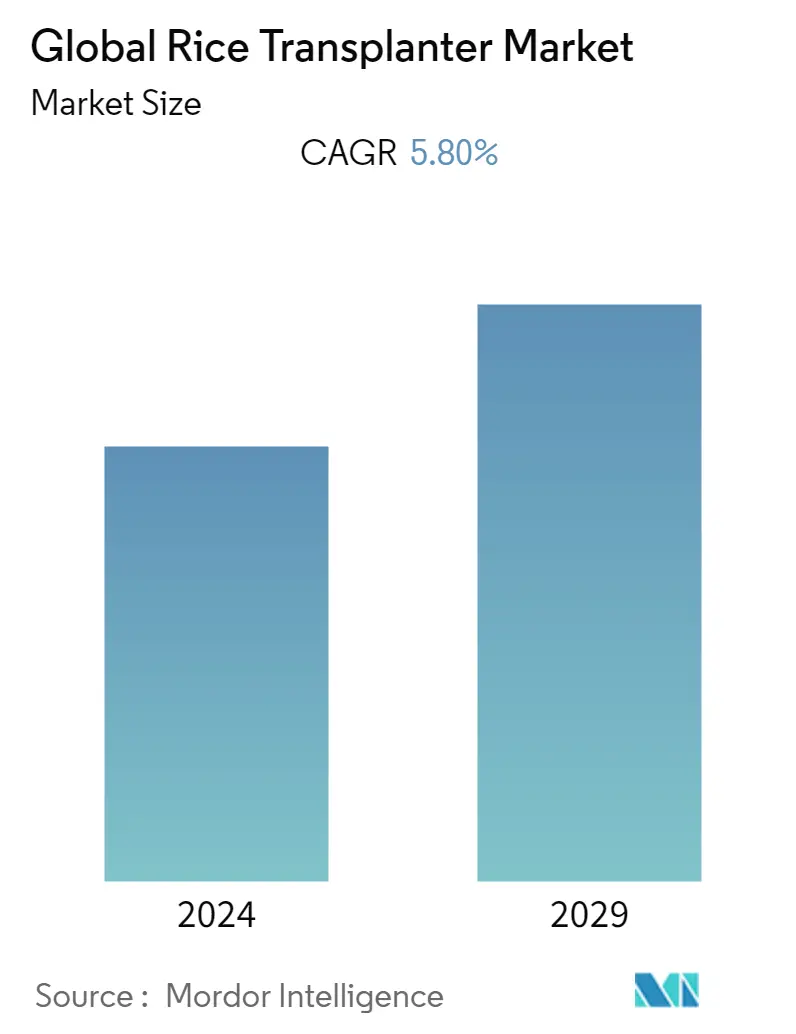Market Size of Global Rice Transplanter Industry

| Study Period | 2019 - 2029 |
| Base Year For Estimation | 2023 |
| CAGR | 5.80 % |
| Fastest Growing Market | Asia Pacific |
| Largest Market | Asia Pacific |
| Market Concentration | Low |
Major Players
*Disclaimer: Major Players sorted in no particular order |
Rice Transplanter Market Analysis
The Global Rice Transplanter Market size is estimated at USD 1.48 billion in 2023, and is expected to reach USD 1.96 billion by 2028, growing at a CAGR of 5.80% during the forecast period (2023-2028).
- The rise in population across the globe is inducing a high demand for food, which in turn is driving the demand for farming machinery such as rice transplanters, especially in regions like Asia. Therefore, agricultural laborers are shifting to urban areas. The global decline in farm labor is the major reason that farm owners opt for agricultural machinery like rice transplanters. According to data from the International Labor Organization (ILO), worldwide, the percentage of people who work in agriculture dropped to 26% in 2022.
- Reducing manpower availability for agricultural work has increased mechanical transplanters' availability because using a self-propelled transplanter gives economic benefits to the farmers over manual transplanting methods. Mechanical transplanting has significantly increased grain yield and decreased drudgery and time compared to manual operations. According to the Indian Council of Food and Agriculture (ICFA), the percentage of agriculture workers in India is estimated to decline by 25.7% in 2050.
- Asia-Pacific is the largest geographical segment of the market studied and accounts for more than half of the total share. Some of the driving factors, like increasing labor shortage work in the paddy fields and continuous technological innovations, have helped increase the efficiency of rice machinery in major rice-producing countries like India and China.
Rice Transplanter Industry Segmentation
A rice transplanter is a specialized transplanter fitted to transplant rice seedlings onto paddy fields.
The global rice transplanter market is segmented by product type (ride-on rice transplanters and walking rice transplanter) and geography (North America, Europe, Asia Pacific, South America, and Africa).
The report offers market estimation and forecasts in value (USD) for the above-mentioned segments.
.
| Product Type | |
| Ride-on Rice Transplanter | |
| Walking Rice Transplanter |
| Geography | |||||||||
| |||||||||
| |||||||||
| |||||||||
| |||||||||
|
Global Rice Transplanter Market Size Summary
The rice transplanter market is experiencing significant growth, driven by the increasing demand for food due to rising global populations, particularly in Asia. This demand is prompting a shift from manual labor to mechanized solutions, as agricultural labor shortages become more pronounced. The decline in agricultural workforce availability is encouraging farm owners to adopt rice transplanters, which offer economic benefits and improved efficiency over traditional methods. The Asia-Pacific region, home to the majority of the world's rice production, is the largest market segment, with countries like India and China leading in adoption due to their substantial rice cultivation areas. The transition to mechanized farming is further supported by technological innovations that enhance the efficiency of rice machinery, addressing labor shortages in paddy fields.
The market is characterized by fragmentation, with numerous small and medium-sized enterprises contributing to competitive dynamics. Major players such as Kubota Inc., Iseki, Mitsubishi, CLASS, and CNH Industrial are actively innovating and expanding their offerings to maintain market share. These companies are investing in research and development to introduce advanced solutions like the Agri-Robo Rice transplanter, which aims to streamline the transplanting process and reduce labor requirements. The ongoing urban migration and aging farmer demographics in developed countries are also contributing to the market's expansion, as mechanized solutions become essential to sustain agricultural productivity. As a result, the rice transplanter market is poised for continued growth, driven by both demand-side factors and technological advancements.
Global Rice Transplanter Market Size - Table of Contents
-
1. MARKET DYNAMICS
-
1.1 Market Overview
-
1.2 Market Drivers
-
1.3 Market Restraints
-
1.4 Porter's Five Forces Analysis
-
1.4.1 Bargaining Power of Suppliers
-
1.4.2 Bargaining Power of Buyers/Consumers
-
1.4.3 Threat of New Entrants
-
1.4.4 Threat of Substitute Products
-
1.4.5 Intensity of Competitive Rivalry
-
-
-
2. MARKET SEGMENTATION
-
2.1 Product Type
-
2.1.1 Ride-on Rice Transplanter
-
2.1.2 Walking Rice Transplanter
-
-
2.2 Geography
-
2.2.1 North America
-
2.2.1.1 United States
-
2.2.1.2 Canada
-
2.2.1.3 Mexico
-
2.2.1.4 Rest of North America
-
-
2.2.2 Europe
-
2.2.2.1 Germany
-
2.2.2.2 United Kingdom
-
2.2.2.3 France
-
2.2.2.4 Italy
-
2.2.2.5 Spain
-
2.2.2.6 Russia
-
2.2.2.7 Rest of Europe
-
-
2.2.3 Asia Pacific
-
2.2.3.1 China
-
2.2.3.2 Japan
-
2.2.3.3 India
-
2.2.3.4 Australia
-
2.2.3.5 Rest of Asia-Pacific
-
-
2.2.4 South America
-
2.2.4.1 Brazil
-
2.2.4.2 Argentina
-
2.2.4.3 Rest of South America
-
-
2.2.5 Africa
-
2.2.5.1 South Africa
-
2.2.5.2 Rest of Middle East & Africa
-
-
-
Global Rice Transplanter Market Size FAQs
What is the current Global Rice Transplanter Market size?
The Global Rice Transplanter Market is projected to register a CAGR of 5.80% during the forecast period (2024-2029)
Who are the key players in Global Rice Transplanter Market?
Kubota, Iseki, Mitsubishi, CLASS and CNH Industrial are the major companies operating in the Global Rice Transplanter Market.

